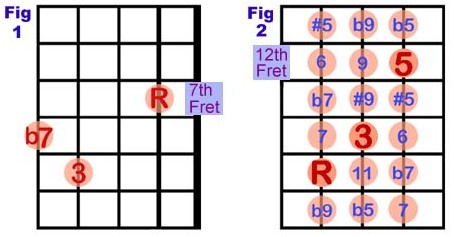






© 2011 Bob Culbertson
Chord Chemistry
This lesson deals with how to locate all of your chords faster. There are 2 diagrams, one for the bass side and one for the melody side. In Fig. 1 it shows the chord we are going to play with the bass side. Fig 2 shows the chord and surrounding tones for the melody side. Note; (all tuning is standard)
This lesson deals with how to locate all of your chords faster. There are 2 diagrams, one for the bass side and one for the melody side. In Fig. 1 it shows the chord we are going to play with the bass side. Fig 2 shows the chord and surrounding tones for the melody side. Note; (all tuning is standard)
The letters represent the parts of the chord in each hand. Ex; R=root, b7=flat 7th, 3=3rd etc; The two chord shapes shown form a D7.(R=D, 3=F#, 5=A, b7= C) If you play the chord shown in Fig 1 , then you can alter the chord shown in the red R-3-5 in Fig 2 to make any chord you wish. One example is to move the 3rd down one whole step to the 9 on the 12th fret, this makes a D9 chord. If you instead move the 5th up a whole step to the 6 it forms a D 13 chord, or if you move the root up a half step to the b9 it forms D7b9. Remember you are playing the 3 most important chord tones in the bass side (b7, 3rd and root) so you can do anything with the melody side. Example; move the 3rd down 1/2 step and move the 5th up 1/2 step, you get.........? but of course, you knew this ! it's........ (D7#5#9) this makes a nice ending chord for a 1-4-5- chord progression This technique can be done with any chord form as long as you play the Root, 7th and 3rd in the bass hand. The key to the whole thing is to learn your melody chords in terms of the parts of the chords that each finger plays. It is easier than you think. One suggestion is to begin with always knowing where the root is.
< Return to Tips Menu
< Return to Tips Menu
